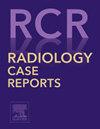Hemorrhagic complication of arachnoid cyst: A case report and literature review
Q4 Medicine
引用次数: 0
Abstract
Arachnoid cysts (ACs) are congenital malformations that can form anywhere in the subarachnoid space along the cerebrospinal axis. While intracystic hemorrhage and subdural hematoma (SDH) are rare, they can be urgent complications that may require emergency craniotomy. This report aims to present a case of an AC complicated by intracystic hemorrhage and SDH. A 63-year-old man presented after a fall, reporting a mild headache, right-sided weakness, confusion, speech difficulties, and gait ataxia. Brain magnetic resonance imaging (MRI) revealed an acute or early subacute SDH. A cystic structure measuring 9 × 6 × 5 cm and showing hemorrhagic characteristics was identified deep within the left SDH. The patient underwent a left-sided craniotomy to evacuate the SDH and remove all surrounding membranes. Additionally, an intracystic hematoma was evacuated, and the cyst wall was fenestrated. The patient remained stable during the follow-up. Over the past decade, a brief literature review on AC complicated by intracystic hemorrhage and SDH identified 9 case reports encompassing ten cases. Patient ages ranged from 6 to 47 years, with only 2 (20%) female patients. Headaches were the most frequent symptom, present in all patients, while eight patients (80%) had no history of head trauma. Only two cases (10%) were treated conservatively. In conclusion, individuals with AC are vulnerable to developing intracystic hemorrhage and SDH, either spontaneously or post-trauma. Open craniotomy combined with cyst fenestration can lead to preferred outcomes in treating this condition.

蛛网膜囊肿出血性并发症1例并文献复习
蛛网膜囊肿(ACs)是一种先天性畸形,可以在蛛网膜下腔沿脑脊髓轴的任何地方形成。虽然囊内出血和硬膜下血肿(SDH)是罕见的,但它们可能是紧急并发症,可能需要紧急开颅手术。本报告的目的是提出一个病例AC合并囊内出血和SDH。一名63岁男性跌倒后入院,报告轻度头痛,右侧无力,意识不清,言语困难,步态共济失调。脑磁共振成像(MRI)显示急性或早期亚急性SDH。左侧SDH深处可见9 × 6 × 5 cm的囊性结构,显示出出血特征。患者接受左侧开颅以排出SDH并去除所有周围膜。此外,囊内血肿被排出,囊肿壁被开孔。随访期间患者病情稳定。在过去的十年中,我们对AC合并囊内出血和SDH进行了简短的文献回顾,发现了9例报告,共10例。患者年龄从6岁到47岁不等,仅有2例(20%)为女性。头痛是最常见的症状,出现在所有患者中,而8名患者(80%)没有头部外伤史。保守治疗仅2例(10%)。总之,患有AC的个体容易发生囊内出血和SDH,无论是自发的还是创伤后的。开颅联合囊肿开颅可获得较好的治疗效果。
本文章由计算机程序翻译,如有差异,请以英文原文为准。
求助全文
约1分钟内获得全文
求助全文
来源期刊

Radiology Case Reports
Medicine-Radiology, Nuclear Medicine and Imaging
CiteScore
1.10
自引率
0.00%
发文量
1074
审稿时长
30 days
期刊介绍:
The content of this journal is exclusively case reports that feature diagnostic imaging. Categories in which case reports can be placed include the musculoskeletal system, spine, central nervous system, head and neck, cardiovascular, chest, gastrointestinal, genitourinary, multisystem, pediatric, emergency, women''s imaging, oncologic, normal variants, medical devices, foreign bodies, interventional radiology, nuclear medicine, molecular imaging, ultrasonography, imaging artifacts, forensic, anthropological, and medical-legal. Articles must be well-documented and include a review of the appropriate literature.
 求助内容:
求助内容: 应助结果提醒方式:
应助结果提醒方式:


